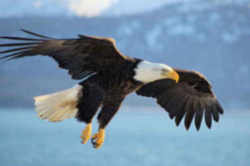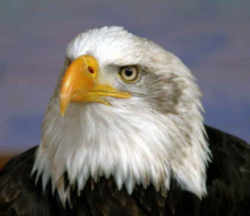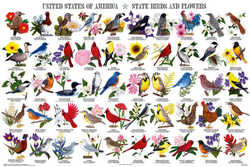
United States National Bird
National Bird: Bald Eagle

(Haliaeetus leucocephalus)
Adopted on June 20, 1782 .
The bald eagle, (Haliaeetus leucocephalus,) was chosen on June 20, 1782 as the emblem of the United States. It was chosen because of its longevity, strength and looks. The choice met some opposition. Ben Franklin felt the eagle was a predator and would be too aggressive a symbol. He thought the wild turkey would be a better choice.
The bald eagle is a large, powerful, brown bird with a white head and tail. The term "bald" does not mean that this bird lacks feathers. Instead, it comes from the word piebald, an old word, meaning "marked with white."
Why was the bald eagle chosen as our national symbol?
The image of the bald eagle can be found in many places in the US, such as on the backs of our gold coins, the silver dollar, the half dollar and the quarter, we see an eagle with outspread wings. On the Great Seal of the United States and in many places which are exponents of our nation's authority we see the same emblem. The eagle represents freedom. Living as he does on the tops of lofty mountains, amid the solitary grandeur of Nature, he has unlimited freedom, whether with strong pinions he sweeps into the valleys below, or upward into the boundless spaces beyond.
The Founding Fathers wanted to choose an animal that was unique to the United States. For six years, the members of Congress engaged in a dispute over what the national emblem should be. As a result of the debate, the bald eagle was chosen because it symbolized strength, courage, freedom, immortality and its association with authority and statehood in fact, the eagle had been used as a symbol of governmental power since Roman times. Also it would look much better as our national symbol.
When Europeans first arrived on the North American continent in the 1600's, there were an estimated 25,000 to 50,000 bald eagles, but populations have since dropped for many reasons. Many eagles were captured for getting too close to poultry or fishing nets; some were captured for falconry; and many eagles were poisoned by pesticides. In 1967, the bald eagle was included on the Endangered Species List. Federal laws, such as the Bald Eagle Protection Act, protect the bald eagle and have led to the recovery of bald eagle populations.
National Bird: The Bald Eagle

A large raptor (bird of prey), the bald eagle has a wingspread of 5?#8218;½ to 8 feet. Adults have a dark brown body and wings, white head and tail, and a yellow beak. In flight, the bald eagle often soars or glides with the wings held at a right angle to the body. Juvenile bald eagles have mottled brown and white plumage, gradually acquiring their dark brown body and distinctive white head and tail as they mature. Bald eagles generally attain adult plumage by 5 years of age. Adults weigh 8 to 14 pounds, occasionally reaching 16 pounds in Alaska. Those in the northern range grow larger than those in the south, and females are somewhat larger than males.
Characteristics of the Bald Eagle
- Length: 32 inches Wingspan: 80 inches
- Sexes similar
- Very large, broad-winged, broad-tailed hawk
- Rounded wings
- Thick, hooked bill
- Plucks fish from water with talons
Adult
Bald eagles can live 15 to 25 years in the wild, and even longer in captivity. Most are capable of breeding at 4 or 5 years of age, but in dense populations they may not start breeding until much older. A pair typically mates for life and builds a huge nest in the tops of large trees near rivers, lakes, marshes, or other aquatic areas. Nests are often re-used year after year, with additions to the nests made annually. Nests are often 4 to 6 feet wide and may weigh up to 1,000 pounds. Although bald eagles may range over great distances, they usually return to nest within 125 miles of where they were raised.
- White head and upper neck
- White tail
- Dark brown body plumage
- Yellow bill
Immature
Nesting activity begins several weeks before egg-laying. Egg-laying dates vary throughout the U.S., ranging from October in Florida, to late April or even early May in the northern United States. The bald eagle nesting season tends to be longer in the southern U.S., and re-nesting following nest failure is more common there as well. In the Pacific Northwest, nest construction begins around January 1, and females typically initiate egg laying soon after February 1. Bald eagles lay one to four eggs a year (typically 2), which hatch after about 35 days of incubation. Only one egg is laid per day, and not always on successive days. Hatching of young occurs on different days, with the result that chicks in the same nest are sometimes of unequal size. Eaglets make their first unsteady flights about 10 to 12 weeks after hatching, and fledge (leave their nests) within a few days after that first flight. However, young birds usually remain in the vicinity of the nest for several weeks after fledging because they are almost completely dependent on their parents for food until they disperse from the nesting territory approximately 6 weeks later
- Dark bill and dark cere
- Dark brown body plumage, including head and tail
- Variable amounts of white on underwing coverts, belly, and back
- White head and tail, and dark underwings are gradually acquired in four years
Taxonomic Hierarchy: Bald Eagle
Kingdom: Animalia - animals
Phylum: Chordata - chordates
Subphylum: Vertebrata - vertebrates
Class: Aves - birds
Order: Ciconiiformes - albatrosses, alcids, auks, cormorants, diurnal birds of prey, eagles, falconiforms, falcons, flamingos,
grebes, gulls, hawks, herons, ibises, loons, osprey, oystercatchers, pelicans, penguins, petrels, plovers, shearwaters, shore birds, storks, totipalmate
swimmers, tube-nosed swimmers
Family: Accipitridae - eagles, hawks, kites
Genus: Haliaeetus Savigny, 1809 - fish eagles
Species: Haliaeetus leucocephalus (Linnaeus, 1766) - ?#402;guila cabeza blanca, bald eagle
Direct Children:
Subspecies: Haliaeetus leucocephalus alascanus
Subspecies: Haliaeetus leucocephalus leucocephalus (Linnaeus, 1766)







